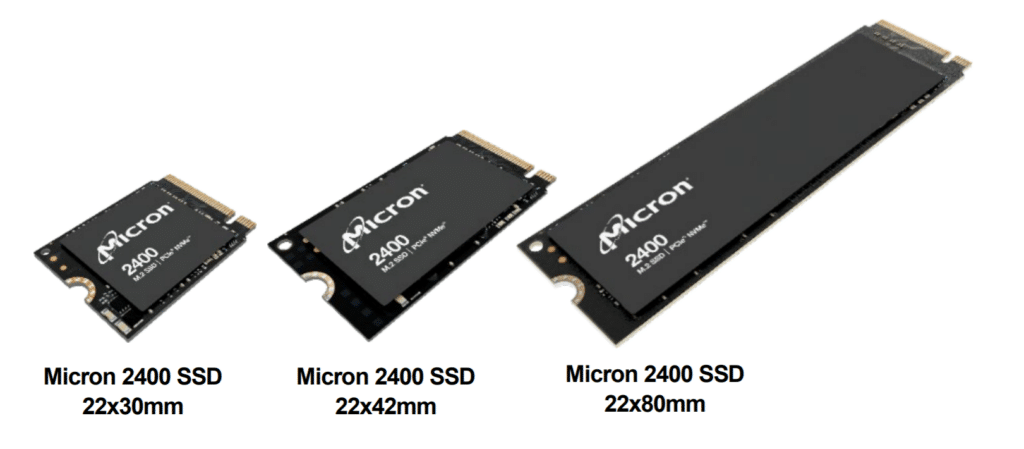Micron has announced they have begun volume shipments of the world’s first 176-layer QLC NAND SSD, featuring the industry’s most advanced QLC NAND architecture to date. Optimized for both storage density and performance in both client and data center environments, Micron’s new NAND technology is now available with the new Micron 2400 SSD. The company also indicates that their 176-layer QLC NAND will also be used inside specific Micron Crucial consumer SSDs, and will be available as a component for system designers.
Micron has announced they have begun volume shipments of the world’s first 176-layer QLC NAND SSD, featuring the industry’s most advanced QLC NAND architecture to date. Optimized for both storage density and performance in both client and data center environments, Micron’s new NAND technology is now available with the new Micron 2400 SSD. The company also indicates that their 176-layer QLC NAND will also be used inside specific Micron Crucial consumer SSDs, and will be available as a component for system designers.

The 176-layer NAND provides an impressive layer count and density for QLC NAND flash, quoting an improvement of 33% for I/O speed and 24% read latency compared to Micron’s previous generation. In addition, its replacement-gate architecture is the only mass-production QLC flash storage that combines charge trap with a CMOS-under-array design. Micron believes that all of these features and improvements will help with the mainstream adoption of QLC SSDs in the client PC market. Thus far the client market has been dominated by Intel with their line of QLC SSDs like the 670p and their Optane/QLC hybrids like the H20.
Micron 2400 176-layer QLC NAND SSD
The Micron 2400 SSD is the industry’s only 2TB 22x30mm M.2 SSD, offering high storage density at a mainstream, value-based price tag. This NVMe SSD features a flexible OEM solution design, combining 176-layer NAND with PCIe Gen4 for double the performance of Micron’s past SSD releases. The company also indicates that it will boast 23% faster read performance, which will certainly help speed up boot and load times.
Its tiny form factor lowers physical space requirements by 63% when compared to the 22x80mm M.2 form factor, which allows for more flexibility when designing systems (especially for small devices like ultra-mobile laptops and tablets). That said, it is also available in 22x42mm and 22x80mm M.2 form factors, all of which feature common firmware to streamline design qualification.
In addition, the 2400 SSD features overall low-power consumption requirements, including a reduction of 50% in active idle power compared to Micron’s previous models. The Micron 2400 SSD is also built to satisfy the Intel Project Athena requirements, which means over nine hours of battery life on laptops with real-world usage.
Micron 2400 SSD Specifications
| Use cases | Value PCIe Gen4 PCs and Notebooks | ||
| Model | Micron 2400 SSD | ||
| Form Factor (mm) | M.2 (22×30, 22×42, 22×80) | ||
| Interface | PCIe Gen4, NVMe 1.4 | ||
| Capacities | 512GB | 1TB | 2TB |
| Sequential Read (MB/s)1 | 4,200 | 4,500 | 4,500 |
| Sequential Write (MB/s)1 | 1,800 | 3,600 | 4,000 |
| Random Read (IOPS)1 | 400K | 600K | 650K |
| Random Write (IOPS)1 | 400K | 650K | 700K |
| Endurance (TBW) | 150TB | 300TB | 600TB |
| MTTF (Million Hours) | 2 | 2 | 2 |
| Sleep/PS4 Power (mW) | <2.5 | <2.5 | <2.5 |
| Active Idle Power (mW) | <150 | <150 | <150 |
| Advanced Features | · Hardware-based AES 256-bit encryption
· RAIN & S.M.A.R.T. · TCG Opal 2.01, TCG Pyrite 2.01 · Micron Storage Executive management tool · Sanitize, Secure Boot |
||
Engage with StorageReview
Newsletter | YouTube | Podcast iTunes/Spotify | Instagram | Twitter | Facebook | TikTok | RSS Feed
